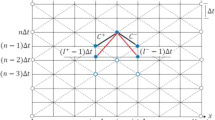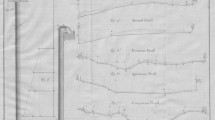Summary
Several formulae have been proposed for treating non-newtonian pipe flow friction data, and with one exception they rely in some way on laminar data for predicting turbulent data. Perhaps the most widely accepted and quoted of these formulae is that due toDodge andMetzner (2) which is also stated to be rigorous.
Some consideration is given to theDodge-Metzner equation which seems to show that far from being rigorous it is not valid for real fluids. Moreover the formula ofBowen (1), which is the exceptional case not requiring laminar flow data, gives superior correlations and is, therefore, to be preferred.
Using a diameter independence hypothesis andBowen's, formula it is possible to find an expression for the turbulent velocity profile. This is checked indirectly by comparing the theoretical and experimental friction factors. In a number of cases (but not all) the comparison is favourable.
Zusammenfassung
Mehrere Formeln sind für die Behandlung der Reibung beim Durchfluß nicht-Newtonscher Flüssigkeiten durch Rohre vorgeschlagen worden. Mit einer Ausnahme werden dabei Daten aus der laminaren Strömung dazu verwendet, um Daten der turbulenten Strömung voraussagen zu können. Die bekannteste dieser Formeln ist diejenige vonDodge undMetzner, von der auch behauptet wird, daß sie streng gilt.
Angestellte überlegungen bezüglich derDodge-Metzner-Gleichnng lassen erkennen, daß diese für reale Flüssigkeiten nicht gilt. überdies gibt die empirische Formel vonBowen (1), die keine Daten der laminaren Strömung benötigt, um auf das turbulente Strömungsverhalten zu schließen, ausgezeichnete Werte und ist daher vorzuziehen.
Bei Anwendung einer Hypothese, wonach eine Unabhängigkeit vom Durchmesser vorhanden ist, und derBowenschen Formel, ist es möglich, einen Ausdruck für das Turbulenz-Geschwindigkeits-Profil zu finden. Diese Beziehung wird indirekt durch Vergleich der theoretischen und experimentellen Reibungsfaktoren überprüft. In einer Anzahl von Fällen (aber nicht in allen) ergibt der Vergleich günstige Resultate.
Similar content being viewed by others
References
Bowen, Le. R., Chem. Engrg. J. June12, 243 (1961); June20, 127 (1961); July10, 147 (1961); July24, 143 (1961); August 7, 129 (1961); August21, 119 (1961); September4, 131 (1961).
Dodge, D. W., Ph.D. Thesis, Univ. (Delaware 1957).
Harris, J., Nature207, 744 (1965).
Harris, J., Nature211, 579 (1966).
Harris, J., The Chemical Engineer45, CE. 30 (1967).
Metzner, A. B. andJ. C. Reed, A.I.Ch.E. J. 434, 1 (1955).
Shorbagi, I. S., M.Sc. Thesis, Univ. (St. Andrews 1967).
Thomas, G., Ph.D. Thesis, Univ. (Wales 1960).
Author information
Authors and Affiliations
Rights and permissions
About this article
Cite this article
Harris, J. The Correlation of non-newtonian turbulent pipe-flow data. Rheol Acta 7, 228–235 (1968). https://doi.org/10.1007/BF01985783
Received:
Issue Date:
DOI: https://doi.org/10.1007/BF01985783




